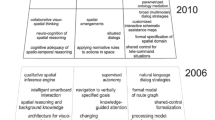Abstract
Present vision systems primarily operate on still images or an image sequence but hardly consider continuous perception across actions. If sensors are attached to the body of a human-like agent who interacts with the environment, several questions arise about how to update the reference systems with each action. In our European research project “Spatial Cognition” we address this topic by a combination of experimental and computational work which should finally merge into a large-scale model of human-like space perception and spatial memory being tested on a humanoid agent in virtual reality.





Similar content being viewed by others
References
Angelaki DE, Cullen KE (2008) Vestibular system: the many facets of a multimodal sense. Annu Rev Neurosci 31:125150
Busch NA, VanRullen R (2010) Spontaneous EEG oscillations reveal periodic sampling of visual attention. Proc Natl Acad Sci USA 107:16048–16053
Byrne P, Becker S, Burgess N (2007) Remembering the past and imagining the future: a neural model of spatial memory and imagery. Psychol Rev 114:340–375
Cavanagh P, Hunt AR, Afraz A, Rolfs M (2010) Visual stability based on remapping of attention pointers. Trends Cogn Sci 14:147–153
Golomb JD, Chun MM, Mazer JA (2008) The native coordinate system of spatial attention is retinotopic. J Neurosci 28:10654–10662
Golomb JD, Pulido VZ, Albrecht AR, Chun MM, Mazer JA (2010) Robustness of the retinotopic attentional trace after eye movements. J Vis 10:19.1–19.12
Hamker FH, Zirnsak M, Ziesche A, Lappe M (2011) Computational models of spatial updating in peri-saccadic perception. Phil Trans R Soc B 366:554–571
Mack A, Rock I (1998) Inattentional blindness. MIT Press, Cambridge
Medendorp WP (2011) Spatial constancy mechanisms in motor control. Phil Trans R Soc B 366:476–491
Melcher D, Colby CL (2008) Trans-saccadic perception. Trends Cogn Sci 12:466–473
Pouget A, Deneve S, Duhamel J-R (2002) A computational perspective on the neural basis of multisensory spatial representations. Nat Rev Neurosci 3:741–747
Rolfs M, Jonikaitis D, Deubel H, Cavanagh P (2011) Predictive remapping of attention across eye movements. Nat Neurosci 14:252–256
Salinas E, Sejnowski TJ (2001) Gain modulation in the central nervous system: where behavior, neurophysiology, and computation meet. Neuroscientist 7:430–440
Simons DJ, Rensink RA (2005) Change blindness: past, present, and future. Trends Cogn Sci 9:16–20
VanRullen R, Carlson T, Cavanagh P (2007) The blinking spotlight of attention. Proc Natl Acad Sci USA 104:19204–19209
Wurtz RH (2008) Neuronal mechanisms of visual stability. Vis Res 48:2070–2089
Ziesche A, Hamker FH (2011) A computational model for the influence of corollary discharge and proprioception on the perisaccadic mislocalization of briefly presented stimuli in complete darkness. J Neurosci 31:17392–17405
Ziesche A, Hamker FH (2014) Brain circuits underlying visual stability across eye movements—converging evidence for a neuro-computational model of area LIP. Front Comput Neurosci 8(25):1–15
Acknowledgments
This project report provides an overview of the EU research project “Spatial Cognition”. Special thanks is given to the further PI’s of the project Neil Burges, Rufin VanRullen, Pieter Medendorp and Patrick Cavanagh who supported this report.
Author information
Authors and Affiliations
Corresponding author
Additional information
This work has been supported by the European Project FP7-NBIS Spatial Cognition “(Grant No. 600785)” and the DFG funded Grossgerät “Mehrbenutzerfähiges Virtual Reality System für kognitive Agenten”.
Rights and permissions
About this article
Cite this article
Hamker, F. Spatial Cognition of Humans and Brain-inspired Artificial Agents. Künstl Intell 29, 83–88 (2015). https://doi.org/10.1007/s13218-014-0338-8
Published:
Issue Date:
DOI: https://doi.org/10.1007/s13218-014-0338-8




